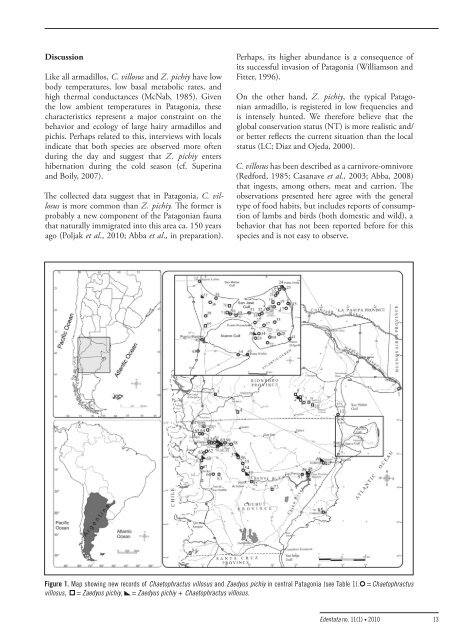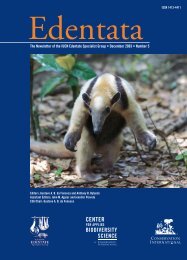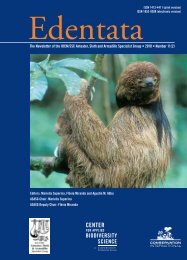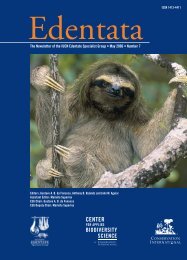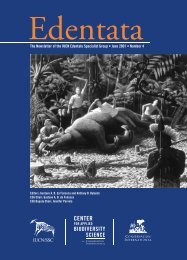Edentata 11(1) - Anteater, Sloth & Armadillo Specialist Group
Edentata 11(1) - Anteater, Sloth & Armadillo Specialist Group
Edentata 11(1) - Anteater, Sloth & Armadillo Specialist Group
Create successful ePaper yourself
Turn your PDF publications into a flip-book with our unique Google optimized e-Paper software.
Discussion<br />
Like all armadillos, C. villosus and Z. pichiy have low<br />
body temperatures, low basal metabolic rates, and<br />
high thermal conductances (McNab, 1985). Given<br />
the low ambient temperatures in Patagonia, these<br />
characteristics represent a major constraint on the<br />
behavior and ecology of large hairy armadillos and<br />
pichis. Perhaps related to this, interviews with locals<br />
indicate that both species are observed more often<br />
during the day and suggest that Z. pichiy enters<br />
hibernation during the cold season (cf. Superina<br />
and Boily, 2007).<br />
The collected data suggest that in Patagonia, C. villosus<br />
is more common than Z. pichiy. The former is<br />
probably a new component of the Patagonian fauna<br />
that naturally immigrated into this area ca. 150 years<br />
ago (Poljak et al., 2010; Abba et al., in preparation).<br />
Perhaps, its higher abundance is a consequence of<br />
its successful invasion of Patagonia (Williamson and<br />
Fitter, 1996).<br />
On the other hand, Z. pichiy, the typical Patagonian<br />
armadillo, is registered in low frequencies and<br />
is intensely hunted. We therefore believe that the<br />
global conservation status (NT) is more realistic and/<br />
or better reflects the current situation than the local<br />
status (LC; Diaz and Ojeda, 2000).<br />
C. villosus has been described as a carnivore-omnivore<br />
(Redford, 1985; Casanave et al., 2003; Abba, 2008)<br />
that ingests, among others, meat and carrion. The<br />
observations presented here agree with the general<br />
type of food habits, but includes reports of consumption<br />
of lambs and birds (both domestic and wild), a<br />
behavior that has not been reported before for this<br />
species and is not easy to observe.<br />
Figure 1. Map showing new records of Chaetophractus villosus and Zaedyus pichiy in central Patagonia (see Table 1). = Chaetophractus<br />
villosus, = Zaedyus pichiy, = Zaedyus pichiy + Chaetophractus villosus.<br />
<strong>Edentata</strong> no. <strong>11</strong>(1) • 2010 13


